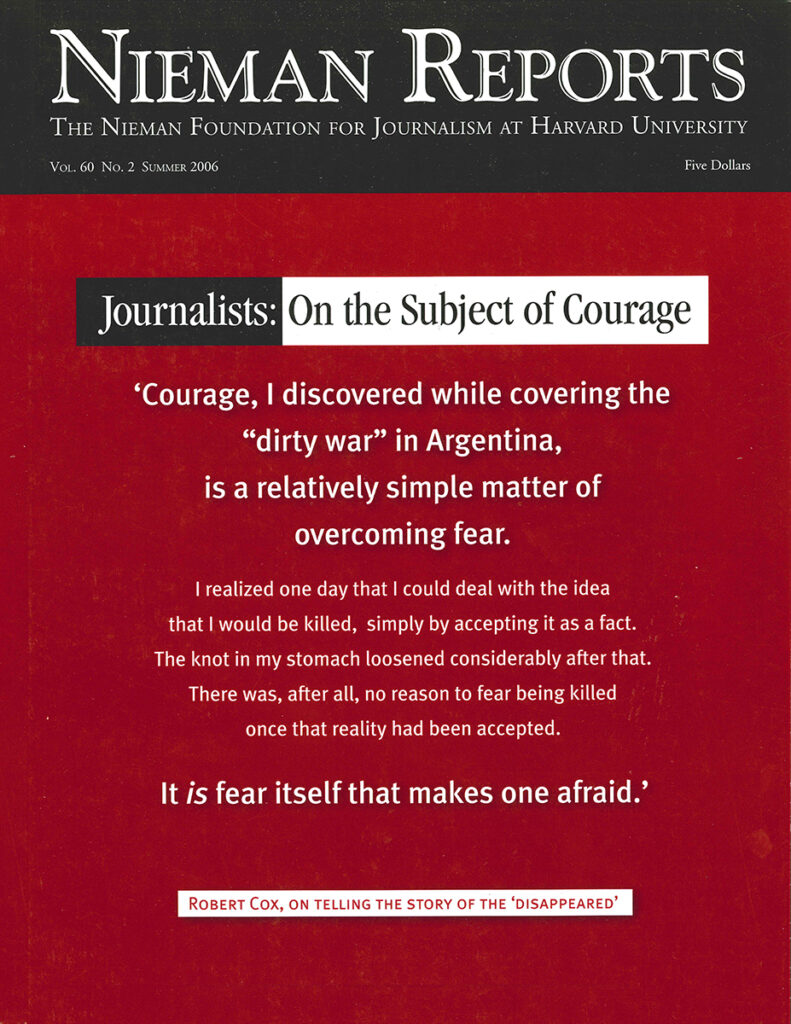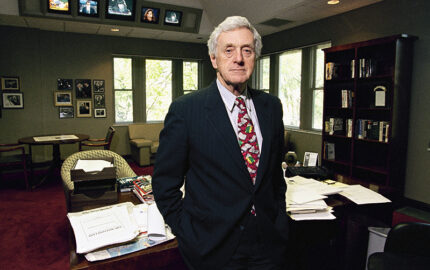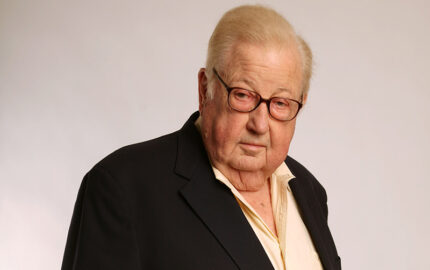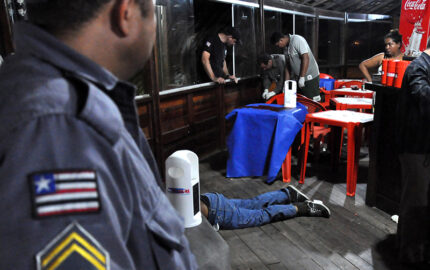
Journalists: On the Subject of Courage
Courage, as these journalists remind us, exposes itself in different guises. It can be found in the wisdom of understanding when danger finally has outweighed the risk. Or it can surface when threats to personal safety lurk but the lessons of training combine with inner strength to push fear aside and persevere. Courage can reside, too, in a journalist's isolation when editorial stands taken shake the foundation of friendship and sever long-held ties to one's community. In this issue, glimpses of such journalistic courage are offered.
Where does courage intersect with journalism? This is a question with many answers, particularly in Colombia where war over drugs, territory and power has been with us — and taken many lives from us — for several decades. In my country, courage is inherent in the daily practice of journalism given the environment in which we, as reporters and editors, must function. At the end of the day, courage for us is just an act of faith — our faith in the hope that our images and words, storytelling done in any way, can help shape the society we live in and keep it from collapsing into complete chaos.
There is a direct connection between the environment in which a journalist works and the effort or courage needed to report. When on a battlefield, the fact of journalists being there speaks to their courage. Once the reporter is there, words or images transmitted have courage as their foundation. To place oneself in the line of fire with the sole purpose of witnessing and reporting to others what's happening in a place of danger is very much about this kind of courage. Words and images are what people often rely on to shape their sense of reality and might be used by those who read or hear them to change the course of events. The essence of courage in journalism comes down to this: What needs to be told is more important than the well-being of the person doing the telling, who risks all to gather information.
War photographers and investigative journalists, particularly in countries where what reporters and editors do inevitably touches sensitive and powerful interests, know this lesson all too well. In Colombia, we certainly do, for in our country so many journalists have been threatened or harmed or lost their lives in the pursuit of information about the warring factions who fight over drugs, land and power.
Marta Soto is the head of the investigative unit at El Tiempo, the largest newspaper in Colombia. In such capacity she daily deals with a steady, unending stream of situations that pose all kinds of risks: politics (the extreme right, extreme left, and extreme civil society), drug trafficking, intervention by the United States, negligent and corrupt governmental authorities, and corruption in the private sector as well. When all of this gets mixed together, what gets forced out are the extremes of journalism. Too often reporting has resulted in the death of reporters or editors, or what happens is that silence descends; this is not to be confused with self-censorship, since silence can be a strategy taken simply to survive.
During recent years, Soto has become accustomed to receiving floral arrangements and notes sent to regret her death, a form of indirect death threats. All kinds of threatening phone calls come her way. She is also often followed on the street. Whatever might scare her is tried. She constantly monitors her bank accounts after learning about an attempt to deposit a large sum of money in her account as a way of involving her in some dark plot. Those intimidating her — and other journalists, as well — are dangerous people. FARC, on the political extreme left, is an internationally recognized terrorist organization that is responsible for thousands of kidnappings and murders each year. The paramilitary units on the extreme right are similar, and the Colombia drug cartels need no introduction; they've earned a worldwide reputation for their brutality.
Soto perseveres despite the dangers, and she teaches other journalists about how to survive in these trenches. Last year she was invited to a journalism school to give the students some guidance about covering drug trafficking. Her wise words offered a lesson in courage as she spoke to them about how to weigh risks and, in part, rely on instinct to survive. A few days after she left, drug dealers went into the journalism school and killed or wounded many who had heard her speak.
My sense is that the courage necessary to undertake all of this begins well before a story is reported or a photograph is taken. This courage is inherent in the search for the truth and the need to cast a light on what is happening so that the evil is exposed instead of being allowed to fade from view. In my work as a reporter and columnist at El Tiempo, I've been a privileged witness to such moments and had to decide whether to denounce a situation regardless of the possible consequences I might face. Consequences can be immediate, but what these tell you as a journalist is that some part of society needed to be touched and situations needed to be brought to light.
The courage journalists display is echoed in the work of others who also decide to write about critical issues while understanding the personal harm that can come to those who do. Their writing is not unlike ours, nor are the risks they take. Such a person is Peter Bunyard, a scientist from Oxford University, who tirelessly travels through the Amazon basin in Colombia — to places where even the Colombian army takes many preventive measures before entering. And he doesn't cease from letting others know about the risks to humanity involved with lowering the Amazon's water and devastating its forests.
I think there is also a hidden courage in those people who live in a developing country who choose journalism as a career. In such countries, journalism is a very low-paid job, but to be able to convey messages of great importance is a great reward. Doing good journalism is synonymous with courage. As journalists, we live to open our eyes and see what others sometimes refuse to see. And we cannot go on without knowing what others might be too frightened to uncover. That is what makes us courageous.
Mauricio Lloreda, a 2004 Nieman Fellow, is an op-ed columnist and analyst with El Tiempo in Bogotá, Colombia.
There is a direct connection between the environment in which a journalist works and the effort or courage needed to report. When on a battlefield, the fact of journalists being there speaks to their courage. Once the reporter is there, words or images transmitted have courage as their foundation. To place oneself in the line of fire with the sole purpose of witnessing and reporting to others what's happening in a place of danger is very much about this kind of courage. Words and images are what people often rely on to shape their sense of reality and might be used by those who read or hear them to change the course of events. The essence of courage in journalism comes down to this: What needs to be told is more important than the well-being of the person doing the telling, who risks all to gather information.
War photographers and investigative journalists, particularly in countries where what reporters and editors do inevitably touches sensitive and powerful interests, know this lesson all too well. In Colombia, we certainly do, for in our country so many journalists have been threatened or harmed or lost their lives in the pursuit of information about the warring factions who fight over drugs, land and power.
Marta Soto is the head of the investigative unit at El Tiempo, the largest newspaper in Colombia. In such capacity she daily deals with a steady, unending stream of situations that pose all kinds of risks: politics (the extreme right, extreme left, and extreme civil society), drug trafficking, intervention by the United States, negligent and corrupt governmental authorities, and corruption in the private sector as well. When all of this gets mixed together, what gets forced out are the extremes of journalism. Too often reporting has resulted in the death of reporters or editors, or what happens is that silence descends; this is not to be confused with self-censorship, since silence can be a strategy taken simply to survive.
During recent years, Soto has become accustomed to receiving floral arrangements and notes sent to regret her death, a form of indirect death threats. All kinds of threatening phone calls come her way. She is also often followed on the street. Whatever might scare her is tried. She constantly monitors her bank accounts after learning about an attempt to deposit a large sum of money in her account as a way of involving her in some dark plot. Those intimidating her — and other journalists, as well — are dangerous people. FARC, on the political extreme left, is an internationally recognized terrorist organization that is responsible for thousands of kidnappings and murders each year. The paramilitary units on the extreme right are similar, and the Colombia drug cartels need no introduction; they've earned a worldwide reputation for their brutality.
Soto perseveres despite the dangers, and she teaches other journalists about how to survive in these trenches. Last year she was invited to a journalism school to give the students some guidance about covering drug trafficking. Her wise words offered a lesson in courage as she spoke to them about how to weigh risks and, in part, rely on instinct to survive. A few days after she left, drug dealers went into the journalism school and killed or wounded many who had heard her speak.
My sense is that the courage necessary to undertake all of this begins well before a story is reported or a photograph is taken. This courage is inherent in the search for the truth and the need to cast a light on what is happening so that the evil is exposed instead of being allowed to fade from view. In my work as a reporter and columnist at El Tiempo, I've been a privileged witness to such moments and had to decide whether to denounce a situation regardless of the possible consequences I might face. Consequences can be immediate, but what these tell you as a journalist is that some part of society needed to be touched and situations needed to be brought to light.
The courage journalists display is echoed in the work of others who also decide to write about critical issues while understanding the personal harm that can come to those who do. Their writing is not unlike ours, nor are the risks they take. Such a person is Peter Bunyard, a scientist from Oxford University, who tirelessly travels through the Amazon basin in Colombia — to places where even the Colombian army takes many preventive measures before entering. And he doesn't cease from letting others know about the risks to humanity involved with lowering the Amazon's water and devastating its forests.
I think there is also a hidden courage in those people who live in a developing country who choose journalism as a career. In such countries, journalism is a very low-paid job, but to be able to convey messages of great importance is a great reward. Doing good journalism is synonymous with courage. As journalists, we live to open our eyes and see what others sometimes refuse to see. And we cannot go on without knowing what others might be too frightened to uncover. That is what makes us courageous.
Mauricio Lloreda, a 2004 Nieman Fellow, is an op-ed columnist and analyst with El Tiempo in Bogotá, Colombia.


